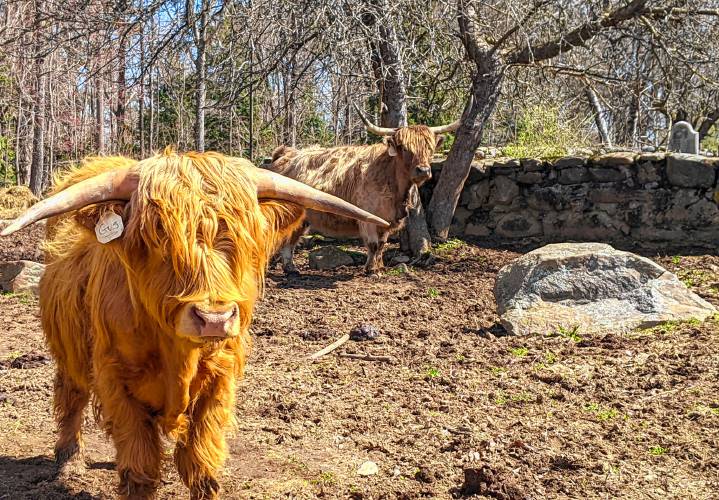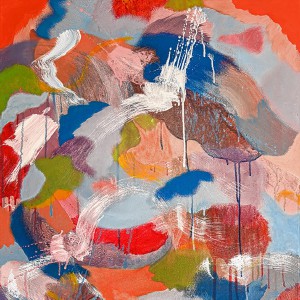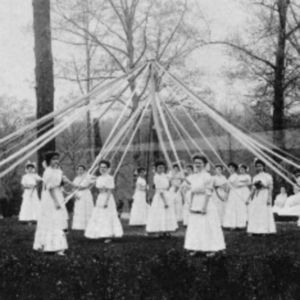From the farm: Spring brings calves, beautiful calves

Both males (bulls) and females (cows) Scottish Highland cattle have horns. Typically, bull horns point down while cow horns point up. Gus, my new bull, has horns that point down, and very-pregnant Hope has horns that point up. Both are standing next to the farm’s cemetery, where the headstone of Miles Smith, who founded the farm in the 1850s, peaks out over the stonewall, keeping an eye on farm operations. Courtesy photograph
| Published: 04-20-2024 7:00 AM |
It’s finally spring, and on Miles Smith Farm, that means baby calves. Spring calves result from careful planning, not by the cows, but by me, the farmer.
Since cow gestation is nine months, Ferdie, the Scottish Highland bull, got to schmooze with the cows late in the summer of 2023. To be sure romance blossomed, Ferdie stayed with his bevy of ladies for two months, which should mean the calves would be born in April or May.
One calf has already arrived. Born on April 4 nor’easter, Stormy has no playmates, so she runs circles around her mom, Magic.
Spring is a perfect time for the little ones to join the farm. There are no flies, warmer weather means newborns won’t freeze to death, and soon, there’ll be lush grass for moms to gorge on to produce milk. There is one small problem with spring births, not for the cattle but for me, the farmer. It’s boot-sucking mud.
My new rubber knee-high boots are great, but when I lose one to the muck, the recovery is awkward, messy, and annoying. Slipperiness is a factor, too. Walking through my pastures is like skating without the skates, and I slide through the muck twice daily to check for newborns.
With four feet and hooves, cows can navigate the slimy stuff better than I can. My feet often go one way, and my body goes another, splatting me in the mud. It’s a softer landing than smashing onto ice, but it leaves me coated in yucky stuff.
During this season of muck and mire, we’ll leave extra hay on the ground. That way, my heavily pregnant cows have an insulated place to rest. Sometimes, six cows will lie together on one pile of hay. Of course, Ferdie takes up the most space, but he always shares with his gals. Good bull.
Birth takes place in the field, usually without human intervention, although husband Bruce or I trek out twice daily to watch each cow when her due date is imminent. And when birth happens, it’s sudden. It usually takes about 15 to 30 minutes from the start of labor to birth. If it takes longer, help is often needed, sometimes by wrapping ropes around the calf’s front legs and pulling while the cow pushes.
Article continues after...
Yesterday's Most Read Articles
Two years ago, we bought a ratchet and brace-like thing to help pull a stuck calf when ropes and human power aren’t enough. Those of you who watch “The Incredible Dr. Pol” on TV know what I’m talking about. Happily, we haven’t had to use that calf extractor yet. If the calf is backward or a leg is bent, a vet’s help is needed to straighten the calf or the leg before pulling.
Even with the mud, I love spring with its symphony of peepers and shoots of daffodils popping from the ground. Adding a few bouncing and leaping calves for an idyllic New Hampshire tapestry is thrilling. This year, I’m sure all the calves will be born and up on their wobbly legs and nursing, all without any help from the farmers. But if that doesn’t happen, well, we’ll be ready.
Carole Soule is co-owner of Miles Smith Farm (milessmithfarm.com), where she raises and sells beef, pork, eggs, and other local products. She can be reached at carole@soulecoaching.com. Carole also coaches humans, helping them achieve the impossible a little at a time.


 PILLAR Gallery + Projects opens fourth exhibition in Concord
PILLAR Gallery + Projects opens fourth exhibition in Concord Concord Community Music School presents Bach’s Lunch: Hildaland
Concord Community Music School presents Bach’s Lunch: Hildaland Concord Chorale presents ‘The Armed Man: A Mass for Peace’ by Karl Jenkins
Concord Chorale presents ‘The Armed Man: A Mass for Peace’ by Karl Jenkins Vintage Views: Our beloved May Day with dancing, horn blowing
Vintage Views: Our beloved May Day with dancing, horn blowing
